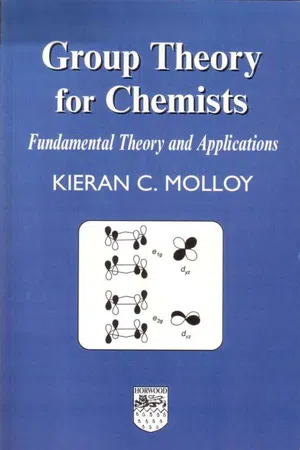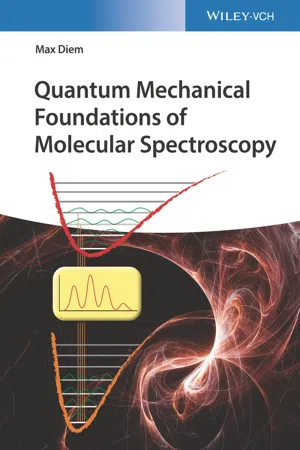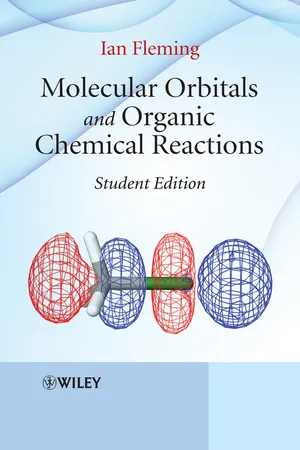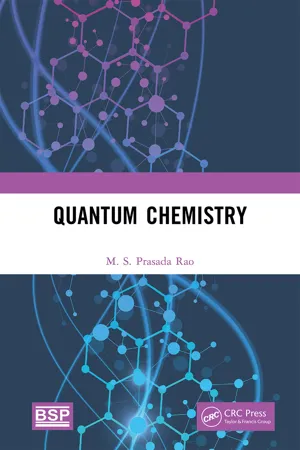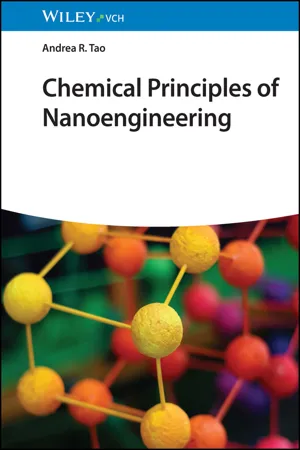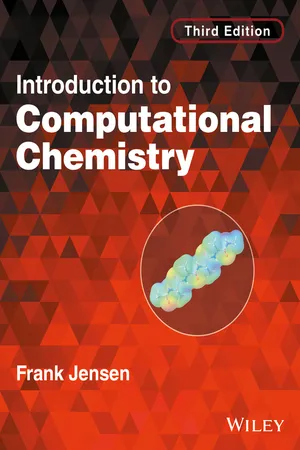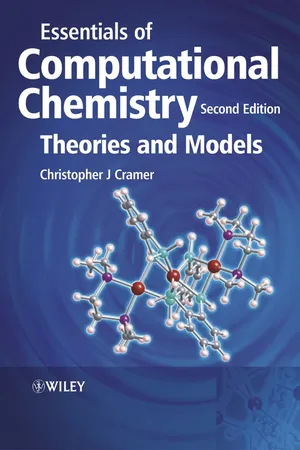Chemistry
Molecular Orbital Theory
Molecular Orbital Theory is a model used to describe the behavior of electrons in molecules. It involves the combination of atomic orbitals to form molecular orbitals, which can be bonding, non-bonding, or anti-bonding. This theory provides a more accurate description of molecular structure and bonding compared to the simpler valence bond theory.
Written by Perlego with AI-assistance
Related key terms
Related key terms
1 of 4
Related key terms
1 of 3
9 Key excerpts on "Molecular Orbital Theory"
- eBook - ePub
- Björn O. Roos, Roland Lindh, Per �ke Malmqvist, Valera Veryazov, Per-Olof Widmark(Authors)
- 2016(Publication Date)
- Wiley(Publisher)
Chapter 3 Molecular Orbital Theory With the introduction of quantum mechanics, we got tools to solve the motion of the particles that build up molecules. In principle, we can compute all of chemistry by solving the Schrödinger equation which for one particle in an external field, represented by the potential energy, is written as 3.1 This is the time-independent Schrödinger equation that describes stationary states that do not evolve with time. This can be written more compactly as 3.2 where we introduce the Hamiltonian operator 3.3 3.4 The Schrödinger equation can be extended to a system of more than one particle, for example, for the hydrogen atom we have 3.5 where the first term is the kinetic energy of the electron, the second term is the kinetic energy of the proton, and the third term is the electrostatic interaction between the two particles. Solving this equation for the hydrogen atom leads us to a one-electron wave function, which we usually refer to as an orbital, and is the basis for atomic and Molecular Orbital Theory. 3.1 Atomic Orbitals When we describe the electronic structure of atoms, we refer to atomic orbitals, that is, solutions to a one-electron Schrödinger equation. The motion of each electron is described by one of these orbitals, and the total wave function of the atom is described by the product of such one-electron wave functions. The orbital that describes the motion of one electron is said to be populated, or occupied, with an electron while the remaining orbitals that are not used in describing the motion of an electron are said to be unpopulated or unoccupied. The logical place to start is by studying the hydrogen atom that indeed only has one electron and is described properly by one occupied orbital. 3.1.1 The Hydrogen Atom The hydrogen atom is the smallest and simplest system of chemical interest. It consists of two particles: an electron and a proton - eBook - ePub
Group Theory for Chemists
Fundamental Theory and Applications
- Kieran C Molloy(Author)
- 2010(Publication Date)
- Woodhead Publishing(Publisher)
Part III Application of Group Theory to Structure and BondingPassage contains an image 6
Fundamentals of Molecular Orbital Theory
In the opening chapter of this part of the book we review the fundamental concepts which underpin the construction of molecular orbital (MO) diagrams, which form the basis of our understanding of both molecular structure and reactivity and are an essential part of modern chemistry. The ideas presented, using the simple molecules H2 and H3 , will form the basis on which we use group theory to guide us in developing descriptions of more complex bonding patterns. The power of group theory will be evident as we move from the interaction of the two or three atomic orbitals (AOs) of H2 , H3 in this chapter to combinations of 19 AOs available for bonding in ferrocene, (C5 H5 )2 Fe in Chapter 10 , with which we shall conclude this part of the book.6.1 BONDING IN H2
When two hydrogen atoms approach each other to form a bond and construct a molecule of H2, the two electrons, one on each of the two atoms, interact with each other. This interaction can be either in-phase and constructive, both electron waves having the same amplitude (ψ), or out-of-phase and destructive, in which the two electron waves have opposite amplitude. These possible combinations of the two 1 s AOs generate two new MOs associated with the whole molecule, one bonding and one anti-bonding in character. The bonding MO concentrates electron density between the nuclei and is thus lower in energy than the AOs from which it is derived, while the anti-bonding MO has reduced electron density between the nuclei and is raised in energy relative to the AOs. In mathematical terms, these two new electron waves (ψbondmg and ψanti-bonding ) can be written in terms of the electron waves associated with each separate hydrogen atom (ψı, ψ2 ) as follows:(eqn. 6.1)(eqn. 6.2) - Max Diem(Author)
- 2021(Publication Date)
- Wiley-VCH(Publisher)
This will be presented in Section 10.1 in a somewhat cursory fashion, because a detailed treatment of Molecular Orbital Theory is far beyond the scope of this book, in particular the computational methods that have been developed in this field. The discussion follows the development presented in a textbook Physical Chemistry by Engel and Reid [ 1 ]. 10.1 Molecular Orbitals and Chemical Bonding in the H 2 + Molecular Ion The first step in understanding electronic spectroscopy is a description of the chemical bond in molecules, in particular the formation and energetics of molecular orbitals. This discussion starts with the simplest of all molecules, the H 2 + molecular ion that consists of two protons and one electron. In analogy to the Hamiltonian that was introduced for a system consisting of a nucleus and two electrons (Eq. [9.1]) (9.1) one defines the Hamiltonian for the H 2 + molecular ion with two nuclei and one electron as (10.1) This equation will need to be augmented for electron–electron repulsion terms in a H 2 molecule with two electrons. Equation (10.1) cannot be solved exactly due to the interdependence of the spatial variables R, r a, and r b. However, it can be solved explicitly after invoking the so‐called Born–Oppenheimer approximation (see Section 10.4): since the nuclei are about 2000 times heavier than electrons, they move much more slowly than the electrons. Thus, one may treat the nuclear coordinates as fixed in their equilibrium position while the electron carries out its motion independently of the nuclear position. This removes the dependence of the total energy on R. Next, the electronic wavefunction of the single electron is written to be delocalized over the two nuclei. One may view the molecular system in the following discussion as a hydrogen atom with a nucleus referred to as “a,” to which a proton, without an electron (nucleus “b”), is added- Ian Fleming(Author)
- 2011(Publication Date)
- Wiley(Publisher)
1 Molecular Orbital Theory 1.1 The Atomic Orbitals of a Hydrogen AtomThe spatial distribution of the electron in a hydrogen atom is usually expressed as a wave function ø where ø 2 d τ is the probability of finding the electron in the volume d τ, and the integral of ø 2 d τ over the whole of space is 1. The wave function is the underlying mathematical description, and it may be positive or negative. Only when squared does it correspond to anything with physical reality—the probability of finding an electron in any given space. Quantum theory gives us a number of permitted wave equations, but the one that matters here is the lowest in energy, in which the electron is in a 1s orbital. This is spherically symmetrical about the nucleus, with a maximum at the centre, and falling off rapidly, so that the probability of finding the electron within a sphere of radius 1.4 Å is 90% and within 2 Å better than 99%. This orbital is calculated to be 13.60 eV lower in energy than a completely separated electron and proton.We need pictures to illustrate the electron distribution, and the most common is simply to draw a circle, Fig. 1.1a , which can be thought of as a section through a spherical contour, within which the electron would be found, say, 90% of the time. Fig. 1.1b is a section showing more contours and Fig. 1.1c is a section through a cloud, where one imagines blinking one’s eyes a very large number of times, and plotting the points at which the electron was at each blink. This picture contributes to the language often used, in which the electron population in a given volume of space is referred to as the electron density. Taking advantage of the spherical symmetry, we can also plot the fraction of the electron population outside a radius r against r , as in Fig. 1.2a , showing the rapid fall off of electron population with distance. The van der Waals radius at 1.2 Å has no theoretical significance—it is an empirical measurement from solid-state structures, being one-half of the distance apart of the hydrogen atoms in the C—H bonds of adjacent molecules. It is an average of several measurements. Yet another way to appreciate the electron distribution is to look at the radial density, where we plot the probability of finding the electron between one sphere of radius r and another of radius r + dr . This has the form, Fig. 1.2b , with a maximum 0.529 Å from the nucleus, showing that, in spite of the wave function being at a maximum at the nucleus, the chance of finding an electron precisely there is very small. The distance 0.529 Å proves to be the same as the radius calculated for the orbit of an electron in the early but untenable planetary model of a hydrogen atom. It is called the Bohr radius a 0- eBook - ePub
- M. S. Prasada Rao(Author)
- 2022(Publication Date)
- CRC Press(Publisher)
Chapter 7 Bonding in Molecules7.1 Molecular Orbital Theory
LCAO Method – H2 + - ionAtom is a centrosymmetric system. However, in molecules it will be disturbed. We shall make a reasonable approximation that a molecular orbital (MO) is a Linear Combination of Atomic Orbitals (LCAO).As individual hydrogen atoms at quite large distance from each other, (theoretically) are brought closer and closer, the nucleus of each atom will start to attract the electrons originally associated with the other atom. The change inenergy of the system, as a function of distance, is usually shown in the form of a curve called a Morse curve.When the distance separating the nuclei is at or near the bonding distance, the electron in the system is associated with the two nuclei instead of the original atomic orbitals on each atom. The electron is now associated with a molecular orbital(MO) that is the combination of the two atomic orbitals.When the electron is near one nucleus, the MO may be assumed to resemble the atomic orbital of the atom. Let the wave function be 01 . Similarly when the electron is in the neighborhood of the other nucleus the MO resembles the atomic orbital of the other atom. The wave function for this is given by 02 . Since the complete MO has the characteristics separately possessed by ϕ1 and ϕ2 , the total wave function for the MO is formed by the linear combination of atomic orbitals. Linear combinations are made by simple addition or subtraction of the functions to be combined. In this case it isψ=m o lϕ 1+ϕ 2This terminology, called the Liner Combination of Atomic Orbitals or LCAO method, was first suggested by R. S. Mulliken.Fig. 7.1.1 Change of energy as a function of distance. - eBook - ePub
Electron Flow in Organic Chemistry
A Decision-Based Guide to Organic Mechanisms
- Paul H. Scudder(Author)
- 2023(Publication Date)
- Wiley(Publisher)
13 QUALITATIVE Molecular Orbital Theory AND PERICYCLIC REACTIONS- 13.1 REVIEW OF ORBITALS AS STANDING WAVES
- Electrons Behave Like Waves (The Wave‐Particle Duality Of Quantum Mechanics). Waves Confined To A Limited Space Are Standing Waves. Orbitals Are Mathematical Descriptions Of Three Dimensional Standing Waves. Standing Waves Have A Series Of Harmonics (Increasing Number Of Half‐Wavelengths) Similar To The Molecular Orbitals For Linear Pi Systems. Mathematically Mixing Atomic Orbitals Gives Molecular Orbitals. Usual Energy Order Of Molecular Orbitals In Large Molecules.
- 13.2 ORBITAL INTERACTION DIAGRAMS
- Greatest Interaction Of Orbitals Occurs When They Are Close In Energy And Have Good Overlap; Increasing Electronegativity Lowers The Energy Of The Atomic Orbitals (AOs); The Lowest Energy AO Contributes The Most To The Lowest Energy MO. HOMO–LUMO Explanation Of Carbanion, Carbocation, And Radical Stability; HOMO–LUMO Explanation Of Nucleophile–Electrophile Interactions in Reactions.
- 13.3 Molecular Orbital Theory FOR LINEAR PI SYSTEMS
- Two p Orbitals: a Simple Pi Bond; Three p Orbitals: the Allyl Unit; Four p Orbitals: the Diene Unit; HOMO and LUMO; General Trends of MO Nodes and Phase
- 13.4 Molecular Orbital Theory FOR CYCLIC CONJUGATED PI SYSTEMS
- Filled Shell, Antiaromaticity; Half‐Filled Shell, Antiaromaticity; 4n + 2 rule for Aromaticity. Circle Trick For Cyclic Conjugated MO Energies.
- 13.5 PERTURBATION OF THE HOMO AND LUMO
- Conjugation Raises the HOMO and Lowers the LUMO; Pi Donors Raise Both the HOMO and LUMO; Pi Acceptors Lower Both the HOMO and LUMO.
- 13.6 DELOCALIZATION OF SIGMA ELECTRONS (MORE ADVANCED)
- Sigma Molecular Orbitals Encompass the Entire Molecule. Hybrid Orbitals Allow for Piecewise Treatment of a Relevant Part of the Sigma System.
- 13.7 CONCERTED PERICYCLIC CYCLOADDITION REACTIONS
- 4n + 2 Supra–Supra Cycloadditions Are Thermally Allowed. The Rules Reverse For Each Phase Change: 4n to 4n
- eBook - ePub
- Andrea R. Tao(Author)
- 2023(Publication Date)
- Wiley-VCH(Publisher)
2 orbital:This allows us to form five equivalent hybrid orbitals by combining one 3s orbital, three 3p orbitals, and one 3d orbital. Thus, the appropriate hybridization is dsp3 .Note that hybrid orbitals do not always have to be equivalent. One can combine different percentages of orbitals to achieve bonding geometries that differ from those listed in Table 2.1 .2.3 Molecular Orbital Theory
In molecular orbital (MO) theory, bonds are formed by sharing electron density over multiple atomic nuclei. Electrons are delocalized over an entire molecule. Delocalization refers to electron motion that is not bound to a single atomic nucleus (Figure 2.12 ), in contrast to VB theory where electrons remain localized to specific atomic nuclei:Delocalized electron motion.Figure 2.12Instead of describing regions of overlap between atomic orbital wavefunctions, MO formalism describes bonding in terms of electron motion associated with molecular orbitals. MOs are formed by taking linear combinations of atomic orbitals, which is why they are sometimes referred to as LCAOs. A basis set or atomic orbital basis is defined as the set of wavefunctions that are used from the LCAOs.Let's again consider two generic atoms, atom A and atom B, that are separated by some internuclear distance. The bond formed between these atoms is described by the electrons that occupy MOs. Each MO can be occupied by a maximum of two electrons. To generate the wavefunction for a MO, we take linear combinations of the atomic orbitals on both atoms:(2.12)where cAand cBare coefficients that describe how much each atomic orbital contributes to the MO,ψ. A larger coefficient signifies that there is a higher probability of finding electrons near a given atomic nucleus. In the simple expression above, we have assumed that each atom only contributes one atomic orbital to bonding. Thus, the atomic basis is made up ofA−BϕandAϕB - eBook - ePub
- Frank Jensen(Author)
- 2016(Publication Date)
- Wiley(Publisher)
16 Qualitative TheoriesAlthough sophisticated electronic structure methods may be able to accurately predict a molecular structure or the outcome of a chemical reaction, the results are often hard to rationalize. Generalizing the results to other similar systems therefore becomes difficult. Qualitative theories, on the other hand, are unable to provide accurate results but they may be useful for gaining insight, for example why a certain reaction is favored over another. They also provide a link to many concepts used by experimentalists. Frontier Molecular Orbital Theory considers the interaction of the orbitals of the reactants and attempts to predict relative reactivities by second-order perturbation theory. It may also be considered as a simplified version of the Fukui function, which considered how easily the total electron density can be distorted. The Woodward–Hoffmann rules allow a rationalization of the stereochemistry of certain types of reactions, while the more general qualitative orbital interaction model can often rationalize the preference for certain molecular structures over other possible arrangements.16.1 Frontier Molecular Orbital Theory
Frontier Molecular Orbital (FMO) theory attempts to predict relative reactivity based on properties of the reactants. It is commonly formulated in terms of perturbation theory, where the energy change in the initial stage of a reaction is estimated and “extrapolated” to the transition state.1 For a reaction where two different modes of reaction are possible, this may be illustrated as shown in Figure 16.1 .Figure 16.1FMO region of a reaction profile.The reaction mode that involves the least - eBook - ePub
Essentials of Computational Chemistry
Theories and Models
- Christopher J. Cramer(Author)
- 2013(Publication Date)
- Wiley(Publisher)
4
Foundations of Molecular Orbital Theory
4.1 Quantum Mechanics and the Wave Function
To this point, the models we have considered for representing microscopic systems have been designed based on classical, which is to say, macroscopic, analogs. We now turn our focus to contrasting models, whose foundations explicitly recognize the fundamental difference between systems of these two size extremes. Early practitioners of chemistry and physics had few, if any, suspicions that the rules governing microscopic and macroscopic systems should be different. Then, in 1900, Max Planck offered a radical proposal that blackbody radiation emitted by microscopic particles was limited to certain discrete values, i.e., it was ‘quantized’. Such quantization was essential to reconciling large differences between predictions from classical models and experiment.As the twentieth century progressed, it became increasingly clear that quantization was not only a characteristic of light, but also of the fundamental particles from which matter is constructed. Bound electrons in atoms, in particular, are clearly limited to discrete energies (levels) as indicated by their ultraviolet and visible line spectra. This phenomenon has no classical correspondence – in a classical system, obeying Newtonian mechanics, energy can vary continuously.In order to describe microscopic systems, then, a different mechanics was required. One promising candidate was wave mechanics, since standing waves are also a quantized phenomenon. Interestingly, as first proposed by de Broglie, matter can indeed be shown to have wavelike properties. However, it also has particle-like properties, and to properly account for this dichotomy a new mechanics, quantum mechanics, was developed. This chapter provides an overview of the fundamental features of quantum mechanics, and describes in a formal way the fundamental equations that are used in the construction of computational models. In some sense, this chapter is historical. However, in order to appreciate the differences between modern computational models, and the range over which they may be expected to be applicable, it is important to understand the foundation on which all of them are built. Following this exposition, Chapter 5 overviews the approximations inherent in so-called semiempirical QM models, Chapter 6 focuses on ab initio
Index pages curate the most relevant extracts from our library of academic textbooks. They’ve been created using an in-house natural language model (NLM), each adding context and meaning to key research topics.
Explore more topic indexes
Explore more topic indexes
1 of 6
Explore more topic indexes
1 of 4

